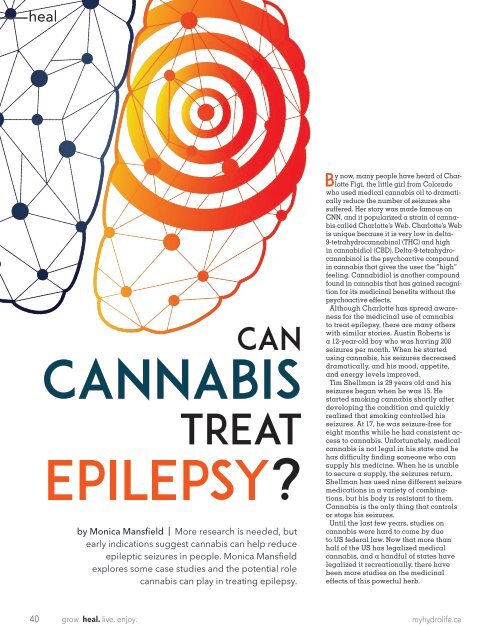Hydrolife Magazine April/May 2017 (Canada Edition)
To know where you’re going, you have to know where you’ve been. The adage rings true for the modern cannabis industry, which is why this issue of Hydrolife takes a look back at the roots of marijuana and how the plant has traveled through history in North America (History of Cannabis Part II).
To know where you’re going, you have to know where you’ve been. The adage rings true for the modern cannabis industry, which is why this issue of Hydrolife takes a look back at the roots of marijuana and how the plant has traveled through history in North America (History of Cannabis Part II).
Create successful ePaper yourself
Turn your PDF publications into a flip-book with our unique Google optimized e-Paper software.
heal<br />
Can<br />
Cannabis<br />
Treat<br />
Epilepsy?<br />
by Monica Mansfield | More research is needed, but<br />
early indications suggest cannabis can help reduce<br />
epileptic seizures in people. Monica Mansfield<br />
explores some case studies and the potential role<br />
cannabis can play in treating epilepsy.<br />
By now, many people have heard of Charlotte<br />
Figi, the little girl from Colorado<br />
who used medical cannabis oil to dramatically<br />
reduce the number of seizures she<br />
suffered. Her story was made famous on<br />
CNN, and it popularized a strain of cannabis<br />
called Charlotte’s Web. Charlotte’s Web<br />
is unique because it is very low in delta-<br />
9-tetrahydrocannabinol (THC) and high<br />
in cannabidiol (CBD). Delta-9-tetrahydrocannabinol<br />
is the psychoactive compound<br />
in cannabis that gives the user the “high”<br />
feeling. Cannabidiol is another compound<br />
found in cannabis that has gained recognition<br />
for its medicinal benefits without the<br />
psychoactive effects.<br />
Although Charlotte has spread awareness<br />
for the medicinal use of cannabis<br />
to treat epilepsy, there are many others<br />
with similar stories. Austin Roberts is<br />
a 12-year-old boy who was having 200<br />
seizures per month. When he started<br />
using cannabis, his seizures decreased<br />
dramatically, and his mood, appetite,<br />
and energy levels improved.<br />
Tim Shellman is 29 years old and his<br />
seizures began when he was 15. He<br />
started smoking cannabis shortly after<br />
developing the condition and quickly<br />
realized that smoking controlled his<br />
seizures. At 17, he was seizure-free for<br />
eight months while he had consistent access<br />
to cannabis. Unfortunately, medical<br />
cannabis is not legal in his state and he<br />
has difficulty finding someone who can<br />
supply his medicine. When he is unable<br />
to secure a supply, the seizures return.<br />
Shellman has used nine different seizure<br />
medications in a variety of combinations,<br />
but his body is resistant to them.<br />
Cannabis is the only thing that controls<br />
or stops his seizures.<br />
Until the last few years, studies on<br />
cannabis were hard to come by due<br />
to US federal law. Now that more than<br />
half of the US has legalized medical<br />
cannabis, and a handful of states have<br />
legalized it recreationally, there have<br />
been more studies on the medicinal<br />
effects of this powerful herb.<br />
40<br />
grow. heal. live. enjoy.<br />
myhydrolife.ca




![Hydrolife Magazine December 2017/January 2018 [CANADIAN EDITION]](https://img.yumpu.com/59790088/1/190x247/hydrolife-magazine-december-2017-january-2018-canadian-edition.jpg?quality=85)
![Hydrolife Magazine December 2017/January 2018 [USA EDITION]](https://img.yumpu.com/59790042/1/190x247/hydrolife-magazine-december-2017-january-2018-usa-edition.jpg?quality=85)
![Hydrolife Magazine October/November 2017 [Canada Edition]](https://img.yumpu.com/59493562/1/190x247/hydrolife-magazine-october-november-2017-canada-edition.jpg?quality=85)
![Hydrolife Magazine October/November 2017 [USA Edition]](https://img.yumpu.com/59493548/1/190x247/hydrolife-magazine-october-november-2017-usa-edition.jpg?quality=85)
![Hydrolife Magazine August/September 2017 [USA Edition]](https://img.yumpu.com/59236656/1/190x247/hydrolife-magazine-august-september-2017-usa-edition.jpg?quality=85)








